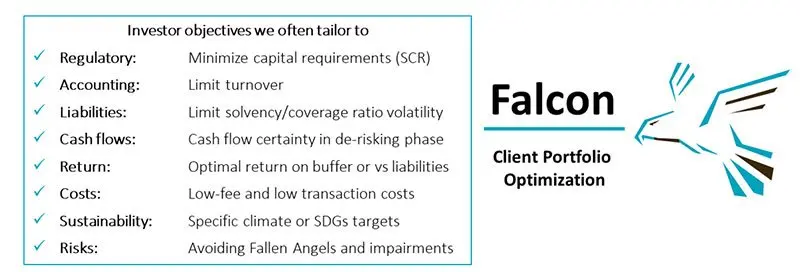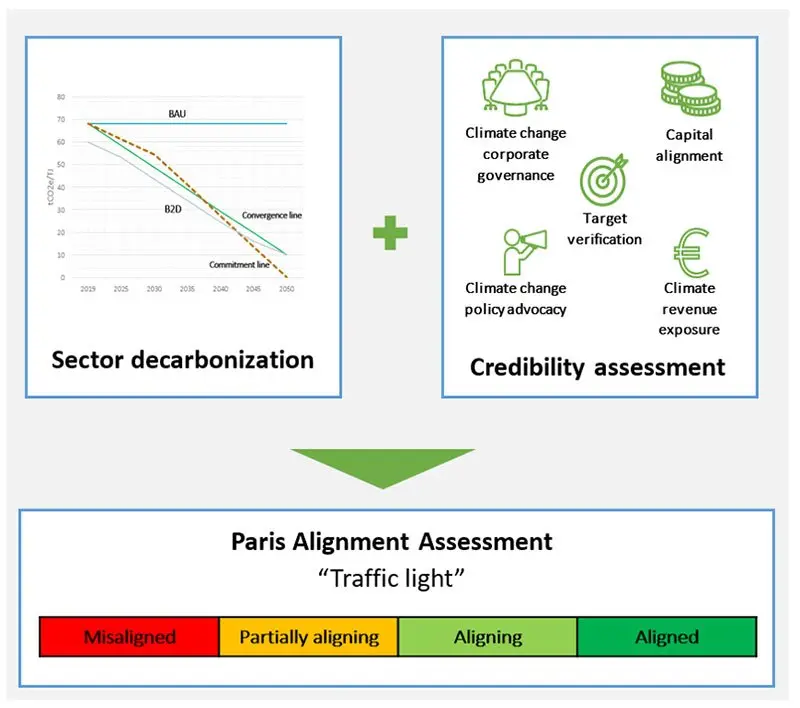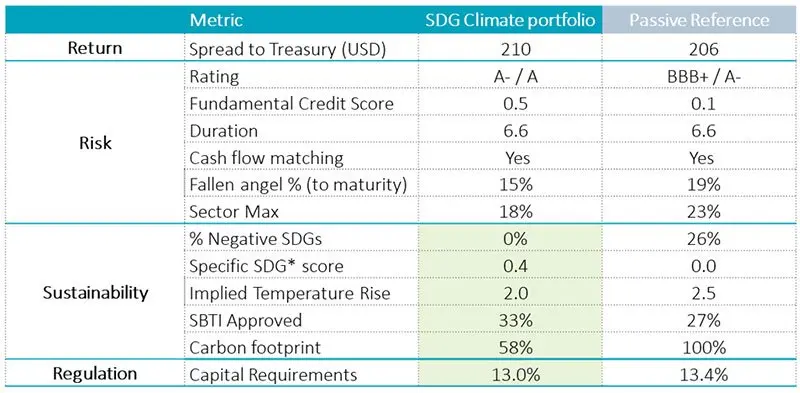Insurers and pension funds face the imperative of finding investment solutions that generate sufficient returns while also managing risk, in a world of high inflation, geopolitical uncertainty and increasing regulation. The focus on sustainability and specifically climate change is also rising, with increasing pressure to set net-zero commitments.
Setting and implementing climate targets are the next steps in this challenge. Targets typically include emission reductions, engagement and investment in climate solutions, with the ultimate aim of reducing real-world emissions and enabling the transition to a low-carbon economy. Implementing these targets requires forward-looking climate analytics that go beyond traditional carbon footprint data and that can be applied to anticipate future emission pathways.
We consider the most effective metrics for building Paris-aligned portfolios and illustrate how they can be used in conjunction with other portfolio metrics to construct buy-and-maintain and constrained credit portfolios.
Climate portfolio optimization challenge
For insurers and pension funds, the challenge is to balance the economic and regulatory profile of the portfolio with restrictions and objectives that are driven by sustainability. Figure 1 shows an overview of the objectives on which we typically optimize portfolios using our proprietary Fixed income Asset & Liability Client Optimization Navigation (FALCON) tooling.
Figure 1 | Typical investor objectives

Source: Robeco. For illustrative purposes only.
When it comes to aligning a portfolio with a net-zero 2050 ambition, an important aspect to consider is the forward-looking portfolio profile of the carbon footprint. Forward-looking climate analytics play an important part in this.
Forward-looking climate analytics
There are different ways of estimating and assessing the future pathway of emissions for a company. We discuss four metrics that we use for this assessment: two proprietary in-house metrics and two external metrics.
1. The Robeco Paris Alignment Assessment (‘Traffic Light’)
The Robeco Traffic Light assesses a company’s degree of alignment with a below 2 °C scenario. The categories of alignment can vary from ‘aligned’, ‘aligning’ and ‘partially aligning’ to ‘misaligned’ (see Figure 2). Our SI research analysts assess a company’s degree of alignment by determining the following:
Are this company’s projected emissions in line with its required sector decarbonization pathway?
Does the company have verified targets and a credible plan for achieving its emission-reduction plans?
Figure 2 | Robeco Paris Alignment assessment

Source: Robeco. For illustrative purposes only.
We use the Paris Alignment assessment for three main purposes: engagement, voting and portfolio construction. While this is our preferred method for assessing the future trajectory of portfolio emissions, external metrics can also be used to assess alignment. Two such metrics are Science Based Targets initiative approval and Implied Temperature Rise.
2. Robeco Climate Risk Assessment
The Traffic Light is also an important input in our fundamental assessment to determine to what extent climate risk could have an impact on a firm’s business fundamentals. This climate risk assessment by our fundamental credit analysts of a company’s credit risk profile has three components: assess the level of climate risk exposure, establish how the firm is dealing with climate risk, and estimate the potential financial impact. It incorporates internal and external metrics. We see this as the most complete assessment of a company’s exposure to climate change and the potential impact on default and downgrade risk.
3. Science Based Targets initiative (SBTi)
The SBTi was created in 2015, following the Paris Agreement, to measure the robustness of companies’ targets relative to the ambition of the Paris Agreement. To do this, the SBTi created sectoral methodologies to determine the required reduction in emissions per sector and to establish which metrics are most relevant. The SBTi assesses whether the trajectories of companies are aligned with different pathways. The main advantages of this metric are that it is simple, has a transparent methodology and is widely used and scrutinized. One of the drawbacks is that it can not confirm the likelihood of a company’s ability to meet its targets.
4. Implied Temperature Rise
Implied Temperature Rise (ITR) metrics reflect an implied global temperature rise that is calculated using a company’s emissions overshoot or undershoot relative to a given carbon budget. It is an intuitive metric that, by making a number of assumptions, data providers are usually able to achieve high coverage of the investment universe. However, the modeling entails significant complexity and various assumptions, which can result in a wide range of possible portfolios and outcomes. And, as is the case with the SBTi, most providers rely on the targets set by companies and do not include any assessment of the credibility of these targets.
There is overlap between these four metrics and each has advantages and disadvantages, ranging from issuer coverage and data quality, to comprehensiveness of assessment. In our view, the metrics are best used in combination, with our fundamental assessments of climate alignment and risk being an overriding factor for issuer selection.
Case study: Balancing climate integration with risk, return and regulatory considerations
We illustrate our approach to incorporating climate targets using a cash flow-matching case study that is a typical for many life insurers or when de-risking a pension scheme. The portfolio in this case study needs to limit the number of fallen angels, match the target cash flow, uphold a minimum rating, have an optimal spread, maintain low capital requirements, make an impact across the SDGs and limit the current and future carbon footprint.
After in-depth client consultation, we construct a portfolio that balances the client’s various risk, return, regulatory and sustainability criteria, and we show across a range of metrics how this portfolio measures up versus a passive reference, as illustrated in Figure 3.
Figure 3 | Case study portfolio characteristics

Source: Robeco, Trucost, SBTI, MSCI, Bloomberg and using September 2022 valuations. For illustrative purposes only and based on model assumptions. Fundamental score ranges between -3, +3 and reflect Robeco’s credit analysts’ assessment of the credit quality. SDG score ranges between -3, +3 and reflects Robeco’s SI analysts’ assessment of the SDG alignment. Carbon footprint is scope 1,2 & 3 and indexed to passive reference. The Fallen Angel % uses average historical rating migration numbers. *refers to the portfolio score on the most climate-related SDGs: 7. Affordable and Clean Energy, 11. Sustainable Cities and Communities and 13. Climate Action.
The SDGs can be used to further generate a targeted impact on specific investors’ sustainability objectives through alignment with a specific set of the UN SDGs. Also, by allocating solely to companies that score positively on the SDGs, an SFDR article 9 portfolio can be created.
免責聲明
本文由荷宝海外投资基金管理(上海)有限公司(“荷宝上海”)编制, 本文内容仅供参考, 并不构成荷宝上海对任何人的购买或出售任何产品的建议、专业意见、要约、招揽或邀请。本文不应被视为对购买或出售任何投资产品的推荐或采用任何投资策略的建议。本文中的任何内容不得被视为有关法律、税务或投资方面的咨询, 也不表示任何投资或策略适合您的个人情况, 或以其他方式构成对您个人的推荐。 本文中所包含的信息和/或分析系根据荷宝上海所认为的可信渠道而获得的信息准备而成。荷宝上海不就其准确性、正确性、实用性或完整性作出任何陈述, 也不对因使用本文中的信息和/或分析而造成的损失承担任何责任。荷宝上海或其他任何关联机构及其董事、高级管理人员、员工均不对任何人因其依据本文所含信息而造成的任何直接或间接的损失或损害或任何其他后果承担责任或义务。 本文包含一些有关于未来业务、目标、管理纪律或其他方面的前瞻性陈述与预测, 这些陈述含有假设、风险和不确定性, 且是建立在截止到本文编写之日已有的信息之上。基于此, 我们不能保证这些前瞻性情况都会发生, 实际情况可能会与本文中的陈述具有一定的差别。我们不能保证本文中的统计信息在任何特定条件下都是准确、适当和完整的, 亦不能保证这些统计信息以及据以得出这些信息的假设能够反映荷宝上海可能遇到的市场条件或未来表现。本文中的信息是基于当前的市场情况, 这很有可能因随后的市场事件或其他原因而发生变化, 本文内容可能因此未反映最新情况,荷宝上海不负责更新本文, 或对本文中不准确或遗漏之信息进行纠正。


